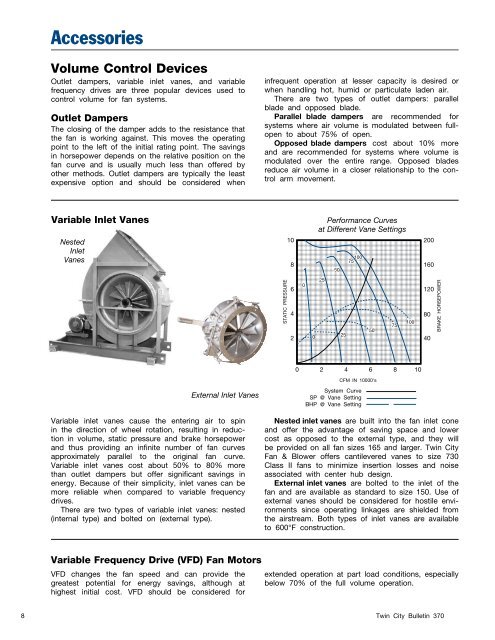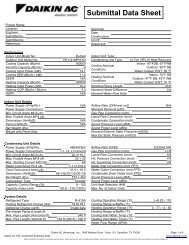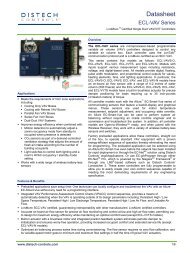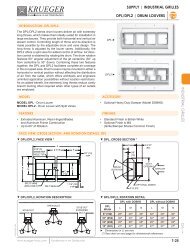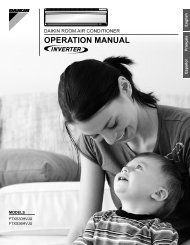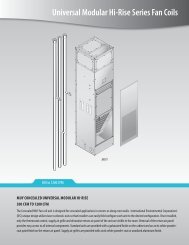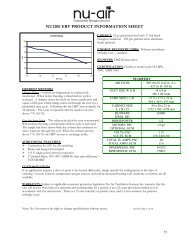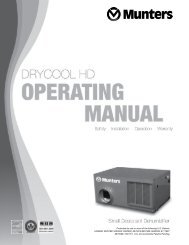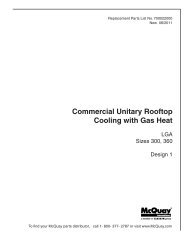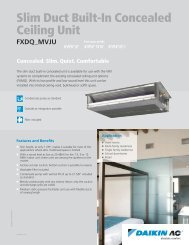Create successful ePaper yourself
Turn your PDF publications into a flip-book with our unique Google optimized e-Paper software.
Accessories<br />
Volume Control Devices<br />
Outlet dampers, variable inlet vanes, and variable<br />
frequency drives are three popular devices used to<br />
control volume for fan systems.<br />
Outlet Dampers<br />
The closing of the damper adds to the resistance that<br />
the fan is working against. This moves the operating<br />
point to the left of the initial rating point. The savings<br />
in horsepower depends on the relative position on the<br />
fan curve and is usually much less than offered by<br />
other methods. Outlet dampers are typically the least<br />
expensive option and should be considered when<br />
infrequent operation at lesser capacity is desired or<br />
when handling hot, humid or particulate laden air.<br />
There are two types of outlet dampers: parallel<br />
blade and opposed blade.<br />
Parallel blade dampers are recommended for<br />
systems where air volume is modulated between fullopen<br />
to about 75% of open.<br />
Opposed blade dampers cost about 10% more<br />
and are recommended for systems where volume is<br />
modulated over the entire range. Opposed blades<br />
reduce air volume in a closer relationship to the control<br />
arm movement.<br />
Variable Inlet Vanes<br />
Nested<br />
Inlet<br />
Vanes<br />
10<br />
8<br />
Performance Curves<br />
at Different Vane Settings<br />
50<br />
100<br />
75<br />
200<br />
160<br />
STATIC PRESSURE<br />
6<br />
4<br />
2<br />
0<br />
0<br />
25<br />
25<br />
50<br />
75<br />
100<br />
120<br />
80<br />
40<br />
BRAKE HORSEPOWER<br />
0 2 4 6 8 10<br />
CFM IN 10000's<br />
External Inlet Vanes<br />
Variable inlet vanes cause the entering air to spin<br />
in the direction of wheel rotation, resulting in reduction<br />
in volume, static pressure and brake horsepower<br />
and thus providing an infinite number of fan curves<br />
approximately parallel to the original fan curve.<br />
Variable inlet vanes cost about 50% to 80% more<br />
than outlet dampers but offer significant savings in<br />
energy. Because of their simplicity, inlet vanes can be<br />
more reliable when compared to variable frequency<br />
drives.<br />
There are two types of variable inlet vanes: nested<br />
(internal type) and bolted on (external type).<br />
System Curve<br />
SYSTEM CURVE<br />
SP @ Vane Setting<br />
SP @ VANE SETTING<br />
BHP @ Vane Setting<br />
BHP @ VANE SETTING<br />
Nested inlet vanes are built into the fan inlet cone<br />
and offer the advantage of saving space and lower<br />
cost as opposed to the external type, and they will<br />
be provided on all fan sizes 165 and larger. Twin City<br />
Fan & Blower offers cantilevered vanes to size 730<br />
Class II fans to minimize insertion losses and noise<br />
associated with center hub design.<br />
External inlet vanes are bolted to the inlet of the<br />
fan and are available as standard to size 150. Use of<br />
external vanes should be considered for hostile environments<br />
since operating linkages are shielded from<br />
the airstream. Both types of inlet vanes are available<br />
to 600°F construction.<br />
Variable Frequency Drive (VFD) Fan Motors<br />
VFD changes the fan speed and can provide the<br />
greatest potential for energy savings, although at<br />
highest initial cost. VFD should be considered for<br />
extended operation at part load conditions, especially<br />
below 70% of the full volume operation.<br />
8<br />
Twin City Bulletin 370


